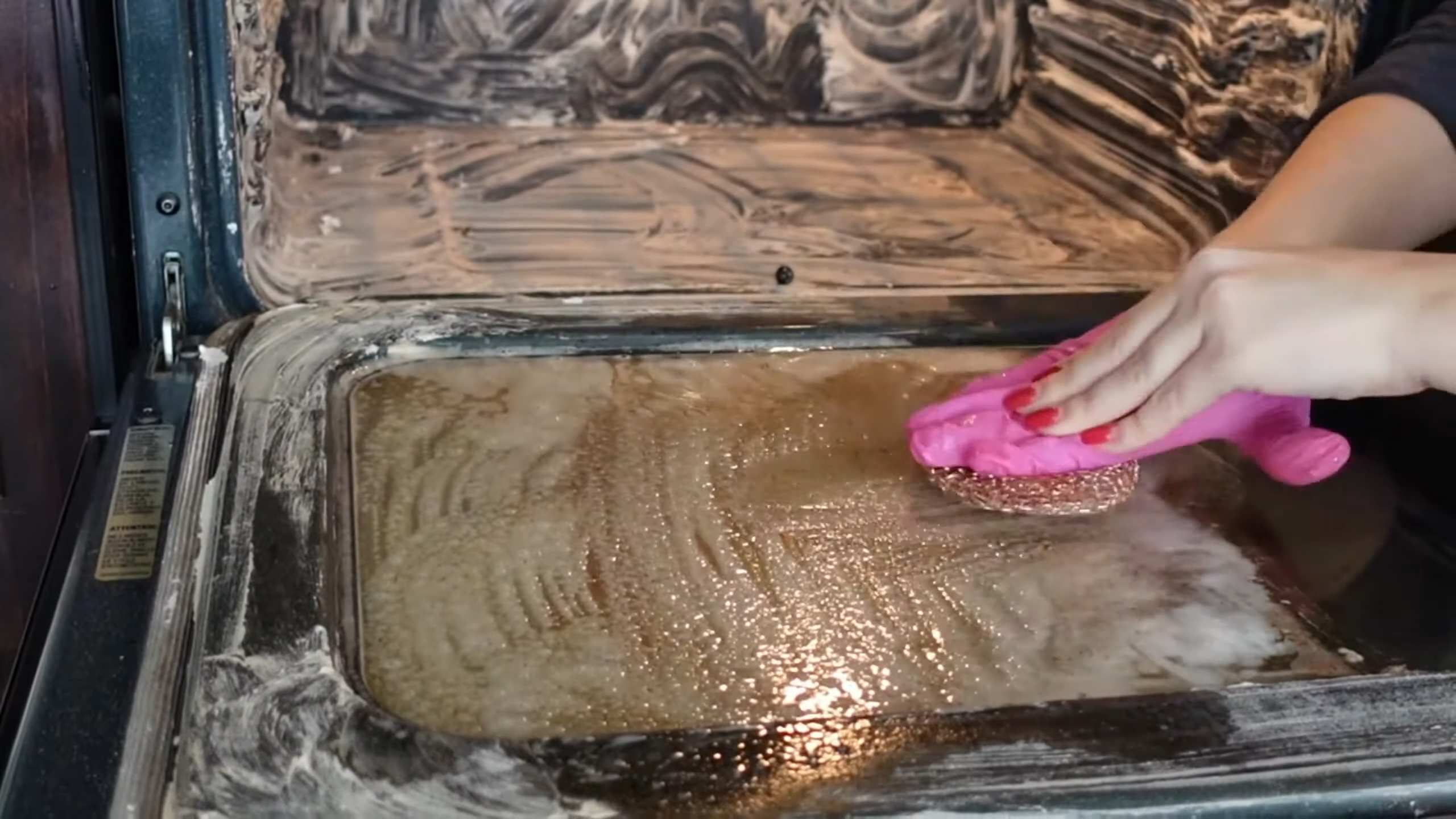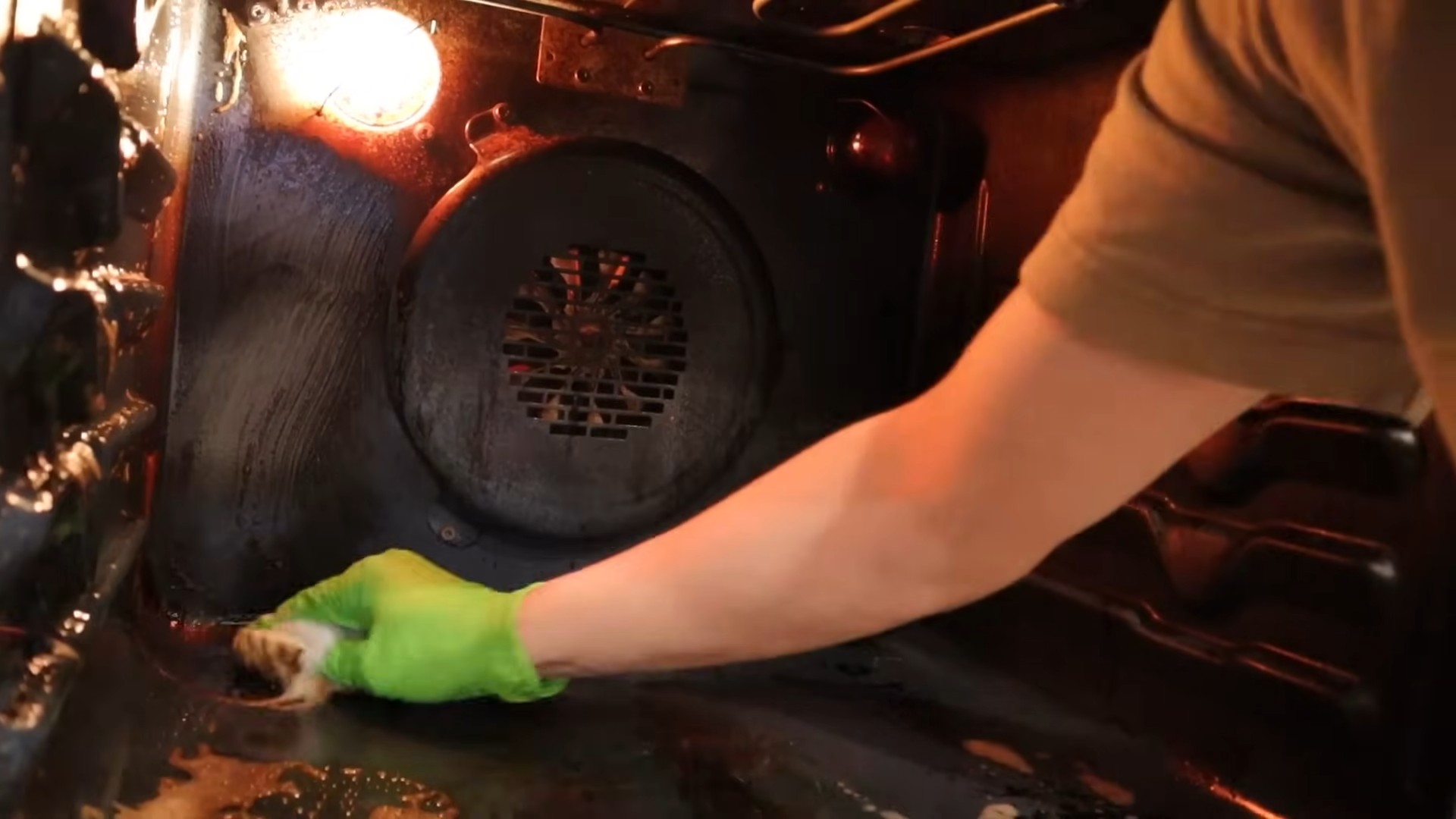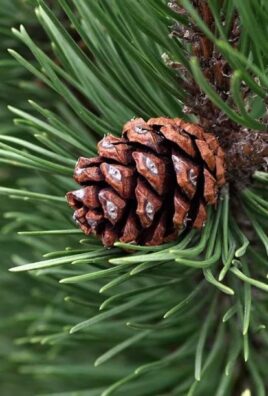Clean Oven Naturally – sounds like a dream, right? I know, tackling a grimy oven can feel like a Herculean task. But what if I told you that you could ditch the harsh chemicals and achieve a sparkling clean oven using ingredients you probably already have in your pantry? This isn’t just another chore; it’s a journey back to simpler, healthier cleaning methods.
For generations, resourceful homemakers have relied on natural cleaning solutions, passing down recipes and techniques that are both effective and eco-friendly. Before the advent of commercial oven cleaners, baking soda and vinegar were the go-to power couple for tackling baked-on messes. Think of this as a modern revival of those time-tested traditions, adapted for today’s busy lifestyles.
Let’s face it, nobody enjoys breathing in the fumes of chemical oven cleaners. They can be harsh on your lungs, irritating to your skin, and even harmful to your pets. Plus, many of us are becoming increasingly aware of the environmental impact of these products. That’s where the magic of a clean oven naturally comes in! This DIY guide will walk you through simple, step-by-step instructions to transform your oven from a greasy disaster zone to a gleaming, food-safe space. Not only will you save money, but you’ll also gain peace of mind knowing you’re creating a healthier home for yourself and your loved ones. So, are you ready to say goodbye to harsh chemicals and hello to a sparkling clean oven, the natural way? Let’s get started!

DIY Oven Cleaning: A Natural and Effective Guide
Okay, let’s face it, cleaning the oven is probably on everyone’s least favorite chore list. But it doesn’t have to involve harsh chemicals and hours of scrubbing! I’m going to walk you through a super effective, natural method that uses ingredients you probably already have in your pantry. Get ready to say goodbye to baked-on grime and hello to a sparkling clean oven!
What You’ll Need:
Before we dive in, let’s gather our supplies. This is a pretty simple process, so the list is short and sweet:
* Baking soda
* White vinegar
* Water
* Spray bottle
* Spatula or scraper (plastic is best to avoid scratching)
* Sponge or scrub brush
* Rubber gloves (optional, but recommended)
* Old rags or paper towels
* Small bowl
Step-by-Step Instructions:
Alright, let’s get started! I promise, it’s easier than you think.
1. Prepare the Oven: First things first, make sure your oven is completely cool. Safety first! Remove the oven racks, pizza stone, or anything else that’s inside. We’ll clean those separately. I usually put them in the sink to soak while I’m working on the oven itself.
2. Create the Baking Soda Paste: In your small bowl, mix together about 1/2 cup of baking soda with enough water to form a thick paste. You want it to be spreadable, but not too runny. Think toothpaste consistency.
3. Coat the Oven: Now, put on your gloves (if you’re using them) and start spreading the baking soda paste all over the inside of your oven. Avoid the heating elements! I usually start with the back and work my way forward. Make sure you get a good, even coating, especially on those stubborn baked-on spots.
4. Let it Sit (Overnight is Best!): This is the key to the whole process. Let the baking soda paste sit for at least 12 hours, or even better, overnight. The longer it sits, the more time it has to loosen up all that grime. I usually do this before I go to bed so it’s ready to go in the morning.
5. Prepare for the Vinegar: After the baking soda has done its thing, grab your spray bottle and fill it with plain white vinegar.
6. Spray the Vinegar: Now, lightly spray the baking soda paste with vinegar. You’ll see it start to fizz and bubble – that’s the magic happening! The vinegar reacts with the baking soda to help break down the remaining grease and grime.
7. Wipe it All Away: Using your sponge or scrub brush, start wiping away the baking soda and vinegar mixture. You might need to use a little elbow grease, especially on those really tough spots. The spatula or scraper can be helpful for dislodging any stubborn bits.
8. Rinse and Repeat (If Necessary): Once you’ve wiped away most of the baking soda mixture, rinse your sponge or scrub brush with clean water and wipe down the oven again to remove any remaining residue. If you still see some stubborn spots, repeat steps 6 and 7.
9. Clean the Oven Racks: Remember those oven racks we soaked earlier? Now’s the time to give them a good scrub with soap and water. Rinse them thoroughly and let them dry.
10. Final Wipe Down: Give the inside of your oven one last wipe down with a clean, damp rag or paper towels to make sure everything is sparkling clean.
11. Dry and Reassemble: Let the oven air dry completely before putting the racks back in.
Cleaning the Oven Door Glass:
Sometimes, the oven door glass can be the dirtiest part! Here’s how I tackle it:
1. Baking Soda Paste (Again!): Make another small batch of baking soda paste, just like we did for the inside of the oven.
2. Apply to the Glass: Spread the paste evenly over the oven door glass, both inside and out.
3. Let it Sit: Let the paste sit for about 15-20 minutes. This will help loosen up any baked-on grease and grime.
4. Wipe and Rinse: Use a damp sponge or cloth to wipe away the baking soda paste. You might need to scrub a little, especially if there’s a lot of buildup. Rinse thoroughly with clean water.
5. Vinegar for Streaks: To get rid of any streaks, spray the glass with white vinegar and wipe it clean with a dry cloth or paper towel.
Dealing with Stubborn Stains:
Okay, sometimes you’ll encounter those super stubborn stains that just don’t want to budge. Here are a few tricks I’ve found helpful:
* Extra Baking Soda: For really tough spots, try applying a thicker layer of baking soda paste and letting it sit for even longer – maybe even a full 24 hours.
* Lemon Juice: Lemon juice is a natural degreaser and can help break down grease and grime. Try squeezing some lemon juice onto the stain and letting it sit for a few minutes before wiping it away.
* Steel Wool (Use with Caution!): If all else fails, you can try using a very fine steel wool pad to gently scrub the stain. Be careful not to scratch the oven surface, especially if it’s coated with enamel. Test it in an inconspicuous area first.
Preventative Measures:
The best way to keep your oven clean is to prevent it from getting too dirty in the first place! Here are a few tips:
* Line the Bottom: Line the bottom of your oven with aluminum foil or a baking sheet to catch any drips or spills.
* Clean Up Spills Immediately: If something spills in your oven, clean it up as soon as possible before it has a chance to bake on.
* Regular Cleaning: Try to clean your oven at least once every few months, even if it doesn’t look that dirty. This will prevent buildup and make the cleaning process much easier.
Why This Method Works:
So, why does this natural method work so well? It’s all about the chemistry!
* Baking Soda: Baking soda is a mild alkali, which means it can help to dissolve grease and grime. It’s also a gentle abrasive, so it can help to scrub away stubborn stains without scratching the oven surface.
* Vinegar: Vinegar is a mild acid, which means it can help to break down mineral deposits and hard water stains. When it reacts with baking soda, it creates carbon dioxide gas, which helps to lift dirt and grime away from the oven surface.
Important Considerations:
* Self-Cleaning Ovens: If you have a self-cleaning oven, you might be tempted to just use that feature. However, the self-cleaning cycle can produce high temperatures and fumes that can be harmful to your health. Plus, it uses a lot of energy. This natural method is a safer and more eco-friendly alternative.
* Oven Coating: Always check your oven’s manual before using any cleaning products, even natural ones. Some ovens have special coatings that can be damaged by certain ingredients.
Final Thoughts:
Cleaning your oven naturally is not only effective but also a healthier and more environmentally friendly option. It might take a little more time and effort than using harsh chemicals, but the results are worth it. Plus, you’ll have the satisfaction of knowing that you’re not exposing yourself or your family to harmful fumes. So, give it a try and see for yourself! I’m confident you’ll be amazed at how clean your oven can get with just a little baking soda and vinegar. Happy cleaning!

Conclusion
So, there you have it! A simple, effective, and completely natural way to clean oven naturally without resorting to harsh chemicals or expensive cleaning products. We’ve walked you through the process, highlighting the ease and affordability of using ingredients you likely already have in your pantry.
Why is this DIY trick a must-try? Because it’s not just about saving money; it’s about creating a healthier home environment. Traditional oven cleaners are often laden with volatile organic compounds (VOCs) that can irritate your lungs, skin, and eyes. By opting for a natural solution like baking soda and vinegar, you’re eliminating those risks and ensuring a safer space for you and your family. Plus, you’re contributing to a more sustainable lifestyle by reducing your reliance on chemical-heavy products.
But the benefits don’t stop there. This method is surprisingly effective at tackling even the most stubborn baked-on grease and grime. The baking soda acts as a gentle abrasive, while the vinegar helps to dissolve stubborn stains. The combination creates a powerful cleaning duo that will leave your oven sparkling clean.
Ready to take it to the next level? Here are a few suggestions and variations to consider:
* Lemon Power: Add a few tablespoons of lemon juice to your baking soda paste for an extra boost of cleaning power and a refreshing citrus scent. The citric acid in lemon juice helps to break down grease and deodorize the oven.
* Essential Oil Infusion: For a pleasant aroma, add a few drops of your favorite essential oil to the baking soda paste. Lavender, tea tree, or eucalyptus oil are all great options for their antibacterial and deodorizing properties.
* Overnight Soak: For particularly stubborn messes, let the baking soda paste sit overnight. This will give it more time to penetrate and loosen the grime, making it easier to wipe away.
* Targeted Cleaning: If you only have a few spots that need attention, you can apply the baking soda paste directly to those areas instead of coating the entire oven.
* Preventative Measures: To keep your oven cleaner for longer, consider using oven liners or baking sheets to catch spills and splatters. Wipe up any messes as soon as they occur to prevent them from baking onto the oven surface.
We are confident that you’ll be amazed by the results of this DIY oven cleaning method. It’s a simple, safe, and effective way to keep your oven sparkling clean without exposing yourself to harmful chemicals.
So, what are you waiting for? Give it a try and see for yourself! We encourage you to share your experience with us in the comments below. Let us know how it worked for you, any variations you tried, and any tips you have to share with other readers. We love hearing from you and learning from your experiences. Together, we can create a community of eco-conscious individuals who are committed to creating healthier and more sustainable homes.
Don’t forget to take before and after photos! We’d love to see your oven transformation. Happy cleaning!
FAQ
Q: Is this method safe for all types of ovens?
A: Generally, yes. This method is safe for most standard ovens, including electric and gas ovens. However, it’s always a good idea to consult your oven’s manufacturer’s instructions before using any cleaning product, even a natural one. Avoid getting the baking soda paste on any heating elements or exposed electrical components. If you have a self-cleaning oven, it’s best to disable that feature before using this method. Also, be cautious when cleaning around the oven door seal, as harsh scrubbing can damage it.
Q: How often should I clean my oven using this method?
A: The frequency of cleaning depends on how often you use your oven and how messy it gets. For most people, cleaning the oven every 1-3 months is sufficient. However, if you frequently bake or cook messy dishes, you may need to clean it more often. A good rule of thumb is to clean your oven whenever you notice a significant buildup of grease or grime. Regular cleaning will prevent messes from becoming too difficult to remove and will keep your oven working efficiently.
Q: What if the baking soda paste doesn’t remove all the grime?
A: If you’re dealing with particularly stubborn grime, there are a few things you can try. First, make sure you’re using a thick enough layer of baking soda paste. The paste should be thick enough to adhere to the oven surfaces and not run. Second, let the paste sit for a longer period of time, ideally overnight. This will give it more time to penetrate and loosen the grime. Third, try using a non-abrasive scrubbing pad or sponge to gently scrub the stubborn areas. Avoid using steel wool or other abrasive materials, as they can scratch the oven surface. Finally, you can try adding a few tablespoons of lemon juice or white vinegar to the baking soda paste for an extra boost of cleaning power.
Q: Can I use this method to clean the oven door glass?
A: Yes, this method is safe and effective for cleaning the oven door glass. Simply apply the baking soda paste to the glass, let it sit for a few minutes, and then wipe it away with a damp cloth or sponge. For stubborn stains, you can use a non-abrasive scrubbing pad. Be sure to rinse the glass thoroughly with clean water to remove any residue. You can also use a glass cleaner after cleaning with baking soda paste for a streak-free shine.
Q: Is it necessary to wear gloves when cleaning the oven with baking soda and vinegar?
A: While baking soda and vinegar are generally safe, it’s always a good idea to wear gloves when cleaning, especially if you have sensitive skin. Baking soda can be slightly abrasive, and prolonged exposure to vinegar can irritate the skin. Wearing gloves will protect your hands from irritation and keep them clean.
Q: How do I get rid of the vinegar smell after cleaning?
A: The vinegar smell should dissipate on its own within a few hours. To speed up the process, you can open the oven door and windows to ventilate the area. You can also place a bowl of baking soda or coffee grounds inside the oven to absorb any lingering odors. Another option is to heat a pot of water with a few slices of lemon on the stovetop. The steam will help to neutralize the vinegar smell and leave a fresh citrus scent.
Q: Can I use this method to clean the oven racks?
A: Yes, you can use this method to clean the oven racks. The easiest way to clean the racks is to soak them in a bathtub filled with hot water and baking soda. Add about 1/2 cup of baking soda to the water and let the racks soak for several hours or overnight. The baking soda will help to loosen the grime, making it easier to scrub away. After soaking, scrub the racks with a non-abrasive brush or sponge and rinse them thoroughly with clean water. You can also apply the baking soda paste directly to the racks and let it sit for a few minutes before scrubbing.
Q: What if I have a self-cleaning oven? Should I still use this method?
A: While self-cleaning ovens are convenient, they can also produce unpleasant odors and consume a lot of energy. If you prefer a more natural and eco-friendly cleaning method, you can still use the baking soda and vinegar method, even if you have a self-cleaning oven. However, it’s important to disable the self-cleaning function before using this method. Also, be sure to remove any loose debris or food particles from the oven before applying the baking soda paste.
Q: Can I use this method on a convection oven?
A: Yes, this method is generally safe to use on convection ovens. However, it’s important to avoid getting the baking soda paste on the convection fan or heating element. If you accidentally get paste on these components, be sure to wipe them clean with a damp cloth. As with any oven, it’s always a good idea to consult your oven’s manufacturer’s instructions before using any cleaning product.
Q: Where can I find more tips on how to clean oven naturally?
A: There are many online resources available that offer tips and advice on how to clean oven naturally. You can search for articles, blog posts, and videos on websites like YouTube, Pinterest, and home improvement blogs. You can also find helpful information in books and magazines about natural cleaning and home organization. Don’t hesitate to experiment with different methods and find what works best for you and your oven.





Leave a Comment